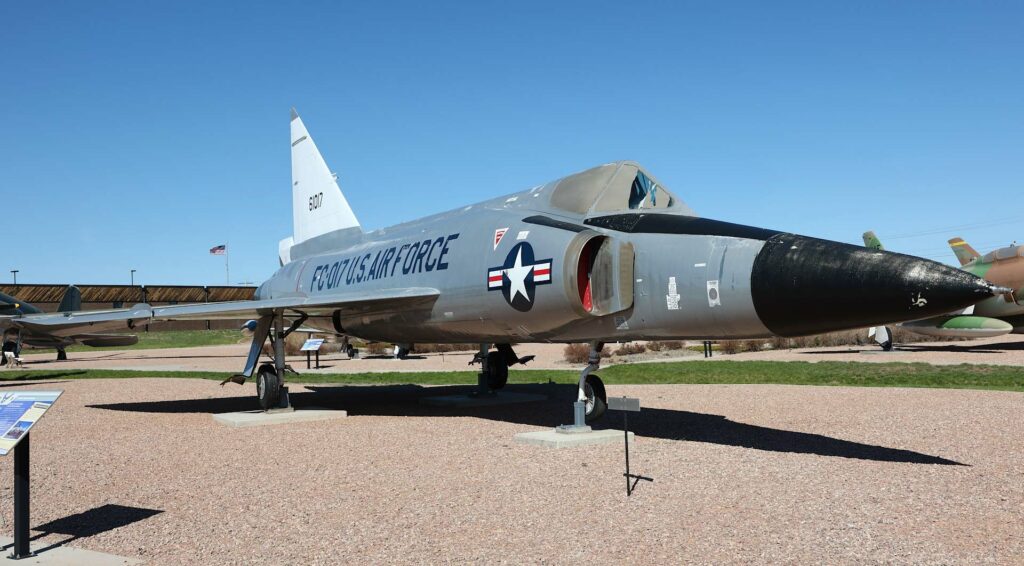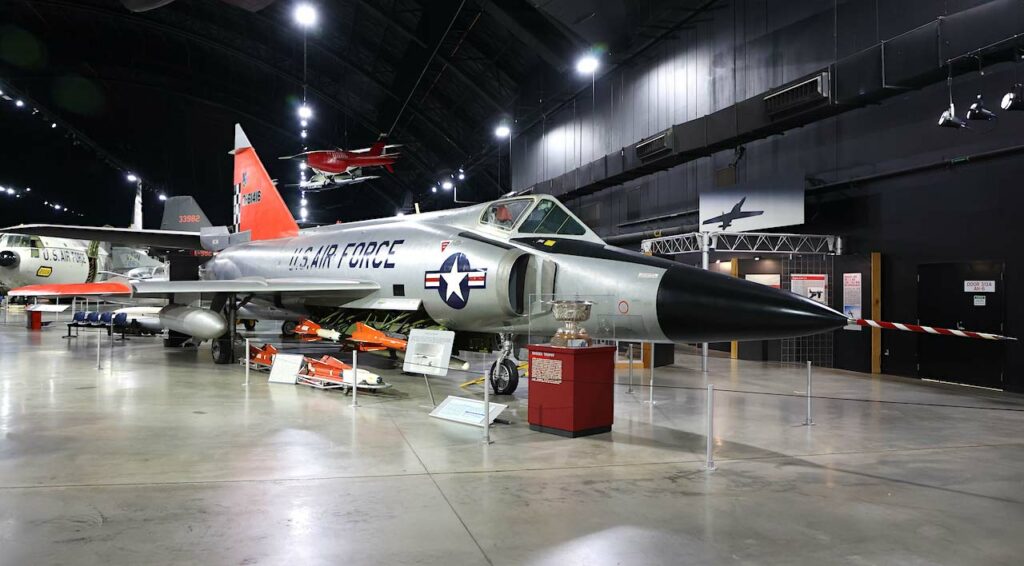First operational supersonic, delta-wing interceptor and fighter of the USAF, designed for Cold War air defense.
In brief
The CONVAIR F-102 Delta Dagger was a groundbreaking American interceptor aircraft, first flown in 1953 and introduced into service in 1956. As the USAF’s first operational supersonic, all-weather jet interceptor and the first to feature a delta-wing design, the F-102 played a vital role in Cold War air defenses. Designed to intercept and destroy enemy aircraft, especially Soviet bombers, the F-102 was equipped with an innovative internal weapons system, housing missiles and rockets. Its design included a unique “area ruling” for reduced drag, contributing to its superior performance. The F-102 was deployed widely across USAF bases in the US, Europe, the Pacific, and Alaska, and saw combat use during the Vietnam War and the 1974 Cyprus invasion. Serving as a critical component of the USAF’s air defenses until its retirement in 1976, the F-102 marked a significant era in military aviation history.
The CONVAIR F-102 Delta Dagger represents a pivotal moment in military aviation, embodying the technological advancements and strategic imperatives of the Cold War era.

History of the Development of the CONVAIR F-102 Delta Dagger
The CONVAIR F-102 Delta Dagger’s development began in the context of the Cold War, a time marked by rapid advancements in jet technology and a heightened need for effective air defense systems. The USAF’s Air Materiel Command issued a request for proposals for an all-weather interceptor in January 1950, seeking a solution to counter the threat of Soviet bombers. Among the proposals submitted, Convair’s design, which featured a delta wing and an internal weapons bay for reduced drag, was selected.
Convair had conducted extensive research into delta-winged aircraft, and their design for the F-102 was innovative for the time. The project, designated MX-1554, aimed to create an interceptor that could meet the high-speed, high-altitude requirements of the era. After Lockheed and Republic were deemed too risky or technologically challenging, Convair’s design was chosen as the most promising.
Construction of the first aircraft began in the early 1950s, but the project faced several challenges, including performance issues and delays in engine development. Initially equipped with the less powerful Westinghouse J40 turbojet, the early prototypes revealed performance limitations, leading to a switch to the Pratt & Whitney J57 turbojet with afterburner. This change, along with other design modifications, improved the aircraft’s capabilities significantly.
The first prototype of the YF-102 made its maiden flight on October 23, 1953, but it was lost in an accident shortly after. The subsequent prototypes confirmed the need for further improvements, particularly in addressing the transonic drag issue. These challenges led to the development of the F-102A, an interim solution pending the more advanced F-102B, which would later evolve into the F-106A, the “Ultimate Interceptor.”
The F-102 Delta Dagger’s development was emblematic of the era’s technological race and strategic competition. As the first operational supersonic interceptor and delta-wing fighter of the USAF, the F-102 was a response to the escalating tensions and technological demands of the Cold War. Its development represented a significant investment in air defense capabilities, reflecting the USAF’s commitment to maintaining air superiority during a critical period in history.
Design of the CONVAIR F-102 Delta Dagger
The design of the CONVAIR F-102 Delta Dagger was a major advancement in military aviation, characterized by its distinctive delta-wing configuration. The delta wing, a triangular wing form, was chosen for its aerodynamic efficiency at high speeds and altitudes, a crucial factor for an interceptor’s performance.
The F-102 had a length of 68.38 feet (20.84 meters), a wingspan of 38.13 feet (11.62 meters), and a height of 21.21 feet (6.46 meters). The aircraft’s empty weight was 19,050 pounds (8,640 kilograms), and its maximum takeoff weight was 31,500 pounds (14,290 kilograms). The F-102’s design also included the innovative “area ruling” concept, which gave the fuselage a Coke bottle-like shape, reducing trans-sonic drag and enhancing its supersonic performance.
Powered by a single Pratt & Whitney J57-23/-25 afterburning turbojet, the F-102 delivered a thrust of 11,700 pounds-force (52.0 kN) and 17,200 pounds-force (76.5 kN) with afterburner. This engine provided the necessary power for the F-102 to achieve its impressive performance capabilities.
One of the notable design aspects of the F-102 was its internal weapons system. The aircraft featured three internal weapons bays and two external hardpoints. It could carry up to two GAR-11/AIM-26 Falcon or up to six GAR-1/2/3/4/AIM-4 Falcon air-to-air missiles, as well as up to 24 2.75-inch Mighty Mouse FFAR rockets. This internal arrangement of armaments was a strategic choice to reduce drag and improve aerodynamic efficiency.
While the F-102’s design had several advantages, it also had drawbacks. The delta wing, while efficient at high speeds, presented challenges at lower speeds and during takeoff and landing. Additionally, the aircraft’s complexity and specialized role as an interceptor limited its versatility compared to more multi-role fighters that emerged later.
Overall, the design of the CONVAIR F-102 Delta Dagger represented a significant leap forward in interceptor technology. Its delta-wing configuration, powerful engine, and advanced aerodynamics set a new standard for fighter aircraft during the Cold War era.
Performance of the CONVAIR F-102 Delta Dagger
The performance of the CONVAIR F-102 Delta Dagger was a key factor in its effectiveness as an interceptor. Designed to engage and destroy enemy aircraft at high speeds and altitudes, the F-102’s performance parameters were crucial to its success.
The F-102’s Pratt & Whitney J57 turbojet engine provided the necessary power for high-speed flight. The aircraft could achieve a maximum level speed of Mach 1.535 at altitude and 685 mph (1,105 km/h) at sea level, making it one of the fastest interceptors of its time. This speed was essential for intercepting fast-moving enemy bombers and ensuring air superiority.
The F-102’s operational ceiling was another important performance aspect. With a service ceiling of 54,000 feet (16,475 meters), the aircraft could operate above most enemy air defenses, increasing its survivability and effectiveness in combat scenarios.
In terms of range, the F-102 had a typical range of 700 nautical miles (1,295 kilometers) and a ferry range of 1,175 nautical miles (2,175 kilometers). This range, combined with its speed and altitude capabilities, made the F-102 a formidable weapon in the USAF’s arsenal.
Comparing the F-102 to its contemporaries, it stood out for its unique design and performance characteristics. While other interceptors of the time, such as the McDonnell F-101 Voodoo, also offered high-speed capabilities, the F-102’s delta-wing design and internal weapons system gave it a distinct advantage in certain operational contexts.
The F-102’s performance was put to the test in various operational scenarios, including during the Vietnam War. Its ability to conduct high-speed interceptions and adapt to different combat roles, such as fighter escort and ground attack, demonstrated its versatility and effectiveness as a military aircraft.
Overall, the performance of the CONVAIR F-102 Delta Dagger was a testament to its design and engineering. Its speed, altitude, and range capabilities made it a critical component of the USAF’s air defense strategy during the Cold War.
Variants of the CONVAIR F-102 Delta Dagger
The CONVAIR F-102 Delta Dagger had several variants throughout its service life, each designed for specific roles and improvements. The primary variants were the F-102A, the TF-102A, and later modifications for drone use.
The F-102A was the production single-seat fighter-interceptor model. A total of 889 F-102As were built, featuring the improvements and modifications necessary to meet the operational requirements of the USAF. This variant was the mainstay of the F-102 fleet and was widely deployed across various USAF bases.
The TF-102A was a two-seat combat-capable trainer variant. Designed with a completely redesigned forward fuselage for side-by-side seating, the TF-102A was used extensively in training new pilots. However, this design modification resulted in a reduction in performance compared to the single-seat variant. A total of 111 TF-102 marks were produced.
In addition to these primary variants, there were drone conversions of the F-102A. These included the QF-102A and PQM-102A/B, which were used as piloted and pilotless target drones for weapons training and trials. These conversions played a crucial role in sharpening the skills of USAF pilots in a realistic training environment.
Each variant of the CONVAIR F-102 Delta Dagger served a specific purpose, reflecting the evolving needs of the USAF. These variants demonstrated the aircraft’s adaptability and the continuous improvement of its design and performance.

Military Use and Combat of the CONVAIR F-102 Delta Dagger
The CONVAIR F-102 Delta Dagger’s military use and combat history are integral to its legacy as an interceptor aircraft. Its primary role was as part of the USAF’s air defense strategy during the Cold War, designed to intercept and destroy enemy bombers, particularly those from the Soviet Union.
In terms of armament, the F-102 was equipped with an internal weapons system that included air-to-air guided missiles and unguided rockets. This configuration allowed the aircraft to engage enemy targets effectively while maintaining high speeds and maneuverability.
The F-102 saw combat use during the Vietnam War, where it was initially deployed as an interceptor. Its speed made it the fastest air defense fighter in the theater, providing a rapid response to enemy incursions. As the war progressed, the F-102 was adapted to different roles, including fighter escort for Boeing B-52 Stratofortress bombers and ground attack missions. Despite these additional roles, the F-102 maintained its presence as an interceptor throughout the war, with only one loss to enemy air-to-air combat.
In addition to its combat use in Vietnam, the F-102 also saw action during the 1974 invasion of Cyprus. It was operated by both Greece and Turkey, who had received the aircraft from the USAF. This deployment highlighted the F-102’s international reach and its role in regional conflicts.
The F-102’s performance in combat situations demonstrated its effectiveness as an interceptor and its adaptability to various military operations. Its ability to carry out these diverse missions underscored its strategic value and versatility as a military aircraft.
In terms of competing aircraft, the F-102 faced various adversaries during its service life. While primarily designed for air defense, its speed and capabilities allowed it to hold its own against other advanced military aircraft of the time. The F-102’s unique design and performance characteristics set it apart from its contemporaries and contributed to its success in operational scenarios.
The CONVAIR F-102 Delta Dagger was also exported to US allies, including Greece and Turkey, expanding its impact beyond the USAF. These exports helped to strengthen international alliances and contribute to global security during a critical period in Cold War history.
The F-102’s service life ended in the 1970s, with the introduction of more advanced, multi-role aircraft. The advent of improved ground-launched intercepting missiles and the shift towards more versatile aircraft led to the decline of dedicated interceptors like the F-102. Its retirement marked the end of an era in military aviation, but its legacy continued through its influence on aircraft design and air defense strategy.
The F-102’s military use and combat history are a testament to its effectiveness as an interceptor. Its ability to adapt to changing strategic needs, its performance in combat, and its role in international relations all contribute to its significance in military aviation history.
The CONVAIR F-102 Delta Dagger’s story is one of technological innovation, strategic importance, and adaptability. From its development as a response to Cold War air defense needs to its retirement in the 1970s, the F-102 played a crucial role in the USAF’s strategy. Its unique design, impressive performance, and combat history make it a significant aircraft in the annals of military aviation. The F-102’s legacy endures as a symbol of an era defined by rapid technological advancements and strategic challenges.
Back to the Fighter Jet section.